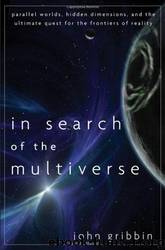In Search of the Multiverse by Gribbin John

Author:Gribbin, John
Language: eng
Format: epub
Publisher: Wiley
Published: 2010-08-09T16:00:00+00:00
BACK TO THE FUTURE
In such a situation, the collapsing half of the bubble would be a mirror image of the expanding half, with radiation falling on to stars to ‘unmake’ complex elements and all the rest that a reversal of the arrow of time would imply. At first sight, this might not seem very different from the idea that the arrow of time points in opposite directions in the two halves of a Boltzmann fluctuation. But there is a crucial difference. In the Boltzmann fluctuation, the arrows are back to back, and both point away from the more ordered state towards the disordered, high entropy state of the greater meta-universe. In the expanding and collapsing bubble universe, the arrows are head to head, and both point towards the state of maximum expansion of the bubble, away from the singularities at either end.
It’s like the difference between two trains on the same track leaving a station in opposite directions, and two trains on the same track heading towards each other in opposite directions. What happens where the arrows meet in the middle? We know what would happen to the two trains; in order to avoid something equally messy in a bubble universe, time would have to reverse, instantaneously, everywhere in the universe at the same time. How does everything in the bubble universe know that it is time to reverse all the processes of thermodynamics? To take just a single, simple example, suppose that a single photon of light has just emerged from the surface of a star and is about to set off into the void when the universe reaches its maximum size. How can that single photon (along with every other photon in the universe) suddenly reverse its motion and head back in to the star from which it has just emerged?
Even if we acknowledge that the flow of time is just an illusion, and that the underlying reality is an array of time slices like Fred Hoyle’s pigeonholes, the only way this would work would be to change the way the ‘memory’ stored in each pigeonhole worked at the point in the stack corresponding to the maximum size of the universe. The pigeonholes on the other side of that dividing line would contain ‘memories’, or records, of what we call the future, not of the past. Both sets of records would describe an expansion from a big bang to a state of maximum expansion. In fact, in order to re-set the entropy clock they would have to describe the same expansion from a big bang. There would be no need for the second half of the stack at all, since it would simply be a duplicate of the first half of the stack. There would not be two big bangs, let alone an infinite array of them, but only one; whichever half of the bubble you lived in, you would see time flowing in just the way we see it today, with a big bang in the past and an expanding universe in the future.
Download
This site does not store any files on its server. We only index and link to content provided by other sites. Please contact the content providers to delete copyright contents if any and email us, we'll remove relevant links or contents immediately.
Tools of Titans by Timothy Ferriss(7803)
Turbulence by E. J. Noyes(7693)
Astrophysics for People in a Hurry by Neil DeGrasse Tyson(4998)
Secrets of Antigravity Propulsion: Tesla, UFOs, and Classified Aerospace Technology by Ph.D. Paul A. Laviolette(4974)
Design of Trajectory Optimization Approach for Space Maneuver Vehicle Skip Entry Problems by Runqi Chai & Al Savvaris & Antonios Tsourdos & Senchun Chai(4837)
Room 212 by Kate Stewart(4730)
Pale Blue Dot by Carl Sagan(4612)
The David Icke Guide to the Global Conspiracy (and how to end it) by David Icke(4376)
A Journey Through Divination and Astronomy by Publishing Pottermore(4247)
Apollo 8 by Jeffrey Kluger(3511)
Goodbye Paradise(3441)
Losing the Nobel Prize by Brian Keating(3424)
COSMOS by Carl Sagan(3346)
The Five People You Meet in Heaven by Mitch Albom(3333)
Brief Answers to the Big Questions by Stephen Hawking(3239)
How to Read Water: Clues and Patterns from Puddles to the Sea (Natural Navigation) by Tristan Gooley(3236)
How to Read Nature by Tristan Gooley(3073)
The Order of Time by Carlo Rovelli(3072)
A Brief History of Time by Stephen Hawking(2819)
